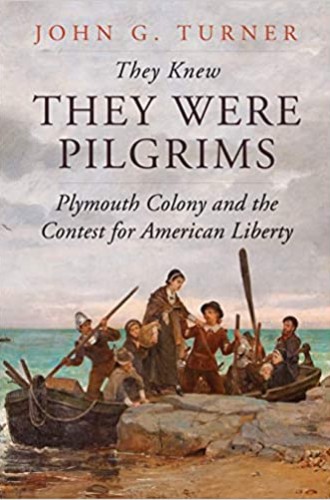A history of the Pilgrims that neither idolizes nor demonizes them
Historian John Turner tells the story of Plymouth Colony with nuance and care.
While attending graduate school in Boston, I would sometimes venture with my wife to the bustling town of Plymouth. We would stroll past the rock, admire the replica of the Mayflower bobbing in the harbor, view the cramped cabin where the compact was signed, and stand before renderings of earnest Pilgrims and friendly American Indians gathered around a Thanksgiving table. Then we would hike up Burial Hill to tour the tombstones dating back nearly four centuries. Markers indicated the time of starvation that took the lives of the majority of the 102 settlers that first winter. The theological rigor and sheer human courage that drove them across the ocean imprinted themselves on our minds.
At the same time, I knew of alternative accounts of the actual history of Plymouth and the Pilgrims who first settled there in 1620. Those accounts offered a grim story not only of ruthless repression of freedom of religion but also of invasion, epidemics, violence, treachery, kidnapping, broken treaties, and the enslavement of hundreds of Wampanoag people who had inhabited the region for centuries.
Read our latest issue or browse back issues.
John G. Turner’s erudite study incorporates elements of both of these scenarios—and adds at least two new ones. First, he highlights the role of irony, ambiguity, complexity, and unintended consequences in the Pilgrim experience. In Turner’s telling, noble aspirations and ignoble behavior continually mix to form shadows where there is light (and light where there is darkness).
Second, Turner features lesser-known actors in the conventional narrative. We learn of male and female sachems who struggled to defend their homes against European encroachment, settlers who condemned other settlers’ rapacity for land and wealth, magistrates who suffered reprisals for their principled stands for something like democracy, and Christian missionaries (both European and Native) who labored at great personal cost and for few rewards.
Turner, who teaches religious studies at George Mason University, is clear about what it means to be a pilgrim. He cites the best-known leader of the group, Governor William Bradford, who in 1630 described the departure from Leiden, alluding to Hebrews 11:13: “They knew they were pilgrims, and looked not much on those things, but lift[ed] up their eyes to the heavens, their dearest country, and quieted their spirits.”
The roots of this pilgrimage go back to the 1580s, when a small group of Protestant dissenters, despairing of reform, started to separate from the Church of England. Facing severe reprisals, including hanging, some emigrated to Amsterdam in search of relative religious freedom. By 1620, several hundred had done so. Finding Holland less hospitable than they expected, a minority determined to move on to the “new” world.
The decision was not undertaken lightly. They knew the peril of the journey and the odds of dying after arrival. Yet they took heart from the now often-quoted words of their pastor, John Robinson: “The Lord hath more truth and light yet to break forth out of His holy Word.”
Aiming for northern Virginia but blown off course, they dropped anchor at the northern tip of Cape Cod on November 11. The occasion prompted both thanksgiving and sober recognition of grim days ahead. “They had now no friends to welcome them, nor inns to entertain or refresh their weather-beaten bodies,” Bradford remembered. Six weeks later, they sighted and then settled at the mouth of an inviting harbor in present-day Plymouth.
The first winter confirmed the Pilgrims’ worst fears. They perished of cold, disease, and malnutrition. But through determination, moxie, and considerable help from the Wampanoag, the Pilgrims managed. By the end of the summer they even enjoyed a measure of bounty, and the fall brought a generous harvest. Turkey (as well as fish, eel, and venison) abounded, although there is no primary record of anything like a formal Thanksgiving meal or celebration.
In 1691 the Plymouth Colony was quietly absorbed into its Puritan neighbor, the Massachusetts Bay Colony, which had been founded in 1630 at Boston. Though Plymouth never rivaled the size, wealth, power, or educational clout of Massachusetts Bay, it persisted as a sturdy outpost of faith for the settlers. Turner details the Pilgrims’ story as an instructive case study of three important long-range trends: changing conceptions of religious liberty; mostly, though not always, tragic interactions with Native Americans; and the remarkable ordinariness of the lives of extraordinary people.
Shifting notions of liberty stood at the center of the Pilgrims’ application of theology to daily life. Calvinists to the bone, they more assumed than argued for God’s absolute sovereignty. Their immediate aim was to secure the liberty to form churches as covenanted communities, nurture and discipline members, interpret the Bible, and sing and pray and worship as they saw fit.
But liberty had limits. Though no one was forced to join a covenanted church, dissidents weren’t free to parade their views in public either. Baptists were tolerated as long as they flew under the radar, but Quakers—who refused to fly under the radar—were harassed, whipped, and imprisoned.
Still, outsiders kept pounding on the door. Antinomian Anne Hutchinson, libertine Thomas Morton, and radical church/state separationist Roger Williams made themselves persistent thorns in the flesh of Plymouth’s leaders. Magistrates gradually relaxed their grip. Toleration never turned into real freedom of religion, but something like grudging pluralism gradually took root.
Liberty also meant freedom to revise or even jettison cherished doctrines when circumstances changed. For example, the venerable concept of predestination meant that hell would be, in Turner’s words, “much more crowded than heaven.” But the extraordinary mortality rate for children in Plymouth forced the adults to rethink their theology. In time, they found peace knowing that most departed children, especially the younger ones, would be safe in God’s arms.
The Pilgrims’ relationship with Native Americans ranged from moments of cooperation to long stretches of wary coexistence to bursts of unrestrained violence. That troubled story constitutes the book’s second theme.
At best, Pilgrims and Natives helped each other with trade, shared resources, and created mutual defense treaties. At worst, both sides—or more often all sides—unleashed acts of appalling violence. Natives scalped their victims alive. Europeans burned their victims alive. The list goes on.
Both the Natives and the Pilgrims were using the military practices common to their respective cultures. The Pilgrims worked within a biblical worldview that sanctioned taking Indians’ land: they believed that the God of the Old Testament authorized bloody aggression for his chosen people back then and his new chosen people now. And Turner writes about a handful of Pilgrim leaders who sharply rebuked their fellows for their cruelty, treachery, and propensity for stealing and swindling.
Still, the reality was that Europeans in general, and Pilgrims in particular, were the invaders of Native lands. Europeans possessed vastly superior numbers, firepower, and technology, so nothing close to an equal fight ever emerged. Europeans imported pandemic diseases for which Natives had no immunity. Europeans enslaved and often resold their captives by the hundreds.
And Christianity? The wonder is not that few Natives converted but rather that any did at all. Some converted for pragmatic reasons, such as education for their children. Some blended indigenous traditions with new teachings. Yet Turner makes clear that, despite all odds, a surprising number took Christian faith to heart and stood by it. Where White preachers made little impact, Native preachers filled the gap.
Turner keeps the narrative buzzing with stories drawn from the warp and woof of everyday life. That is the third theme: for all of their quirks and limitations, Pilgrims were not so different from most people today. The Mayflower’s manifest included two dogs, a Mastiff and a small spaniel. There was one child born en route, named Oceanus. Elder William and Mary Brewster named their children Patience, Fear, Love, and Wrestling.
And then there is the saga of Nathaniel and Dorothy Clarke. After moving out of their home, Turner tells us,
Dorothy petitioned the General Court for a divorce, accusing her husband of impotency by reason of deformity. Puritans expected married couples to maintain conjugal relations, for pleasure as well as procreation. . . . The court appointed three physicians to examine Nathaniel Clarke’s genitals (at his expense), which they judged to be without defect. . . . The colony’s leaders therefore brokered an agreement.
Turner is a master stylist. Though the book is not beach reading—major works of history rarely are—it is packed with wit and choice quotations. The Pilgrims, he memorably tells us, described the charismatic sachem Massasoit as a “very lusty [strong] man, in his best years, an able body, grave of countenance, and spare of speech.” Turner also understands that less is more. He abstains from using polarizing, thought-stopping terms. He trusts readers to weigh the evidence and then judge for themselves.
Christianity Today granted its 2021 Award of Merit in History and Biography to They Knew They Were Pilgrims—and for good reason. Turner helps us appreciate the Pilgrims’ accomplishments, regret their failures, and empathize with their struggles. If the book takes us back into a world we have lost, it is also a world that feels strangely familiar. And that is no small feat.
A version of this article appears in the print edition under the title “Complex pilgrims.”







